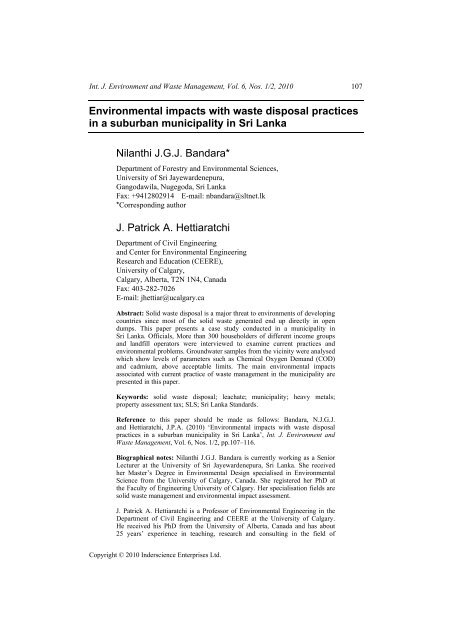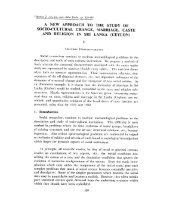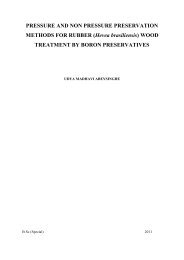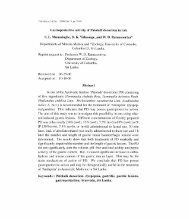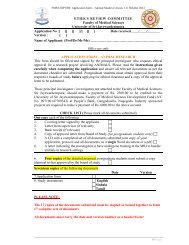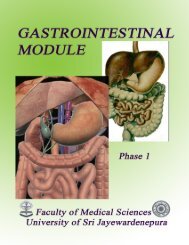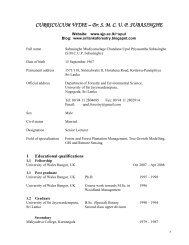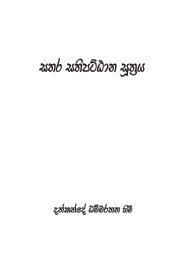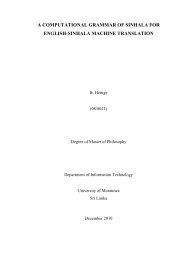Environmental impacts with waste disposal practices in a suburban ...
Environmental impacts with waste disposal practices in a suburban ...
Environmental impacts with waste disposal practices in a suburban ...
You also want an ePaper? Increase the reach of your titles
YUMPU automatically turns print PDFs into web optimized ePapers that Google loves.
Int. J. Environment and Waste Management, Vol. 6, Nos. 1/2, 2010 107<br />
<strong>Environmental</strong> <strong>impacts</strong> <strong>with</strong> <strong>waste</strong> <strong>disposal</strong> <strong>practices</strong><br />
<strong>in</strong> a <strong>suburban</strong> municipality <strong>in</strong> Sri Lanka<br />
Nilanthi J.G.J. Bandara*<br />
Department of Forestry and <strong>Environmental</strong> Sciences,<br />
University of Sri Jayewardenepura,<br />
Gangodawila, Nugegoda, Sri Lanka<br />
Fax: +9412802914 E-mail: nbandara@sltnet.lk<br />
*Correspond<strong>in</strong>g author<br />
J. Patrick A. Hettiaratchi<br />
Department of Civil Eng<strong>in</strong>eer<strong>in</strong>g<br />
and Center for <strong>Environmental</strong> Eng<strong>in</strong>eer<strong>in</strong>g<br />
Research and Education (CEERE),<br />
University of Calgary,<br />
Calgary, Alberta, T2N 1N4, Canada<br />
Fax: 403-282-7026<br />
E-mail: jhettiar@ucalgary.ca<br />
Abstract: Solid <strong>waste</strong> <strong>disposal</strong> is a major threat to environments of develop<strong>in</strong>g<br />
countries s<strong>in</strong>ce most of the solid <strong>waste</strong> generated end up directly <strong>in</strong> open<br />
dumps. This paper presents a case study conducted <strong>in</strong> a municipality <strong>in</strong><br />
Sri Lanka. Officials, More than 300 householders of different <strong>in</strong>come groups<br />
and landfill operators were <strong>in</strong>terviewed to exam<strong>in</strong>e current <strong>practices</strong> and<br />
environmental problems. Groundwater samples from the vic<strong>in</strong>ity were analysed<br />
which show levels of parameters such as Chemical Oxygen Demand (COD)<br />
and cadmium, above acceptable limits. The ma<strong>in</strong> environmental <strong>impacts</strong><br />
associated <strong>with</strong> current practice of <strong>waste</strong> management <strong>in</strong> the municipality are<br />
presented <strong>in</strong> this paper.<br />
Keywords: solid <strong>waste</strong> <strong>disposal</strong>; leachate; municipality; heavy metals;<br />
property assessment tax; SLS; Sri Lanka Standards.<br />
Reference to this paper should be made as follows: Bandara, N.J.G.J.<br />
and Hettiaratchi, J.P.A. (2010) ‘<strong>Environmental</strong> <strong>impacts</strong> <strong>with</strong> <strong>waste</strong> <strong>disposal</strong><br />
<strong>practices</strong> <strong>in</strong> a <strong>suburban</strong> municipality <strong>in</strong> Sri Lanka’, Int. J. Environment and<br />
Waste Management, Vol. 6, Nos. 1/2, pp.107–116.<br />
Biographical notes: Nilanthi J.G.J. Bandara is currently work<strong>in</strong>g as a Senior<br />
Lecturer at the University of Sri Jayewardenepura, Sri Lanka. She received<br />
her Master’s Degree <strong>in</strong> <strong>Environmental</strong> Design specialised <strong>in</strong> <strong>Environmental</strong><br />
Science from the University of Calgary, Canada. She registered her PhD at<br />
the Faculty of Eng<strong>in</strong>eer<strong>in</strong>g University of Calgary. Her specialisation fields are<br />
solid <strong>waste</strong> management and environmental impact assessment.<br />
J. Patrick A. Hettiaratchi is a Professor of <strong>Environmental</strong> Eng<strong>in</strong>eer<strong>in</strong>g <strong>in</strong> the<br />
Department of Civil Eng<strong>in</strong>eer<strong>in</strong>g and CEERE at the University of Calgary.<br />
He received his PhD from the University of Alberta, Canada and has about<br />
25 years’ experience <strong>in</strong> teach<strong>in</strong>g, research and consult<strong>in</strong>g <strong>in</strong> the field of<br />
Copyright © 2010 Inderscience Enterprises Ltd.
108 N.J.G.J. Bandara and J.P.A. Hettiaratchi<br />
<strong>Environmental</strong> Eng<strong>in</strong>eer<strong>in</strong>g. His current research is <strong>in</strong> the areas of susta<strong>in</strong>able<br />
landfill technology, greenhouse gas emissions control, optimisation of landfill<br />
operation and construction <strong>waste</strong> recycl<strong>in</strong>g. He has published extensively <strong>in</strong><br />
these areas. In recognition of his significant contributions and achievements<br />
<strong>in</strong> the areas of Biocell technology development and biological methane<br />
oxidation, he has received a number prestigious awards <strong>in</strong>clud<strong>in</strong>g the 2007<br />
Alberta Emerald Award for Research and Innovation from the Alberta Emerald<br />
Foundation, 2008 Shell/ASTECH Award for <strong>Environmental</strong> Innovation from<br />
Alberta Science and Technology (ASTech) Leadership Foundation, and 2009<br />
Summit Award for Environment and Susta<strong>in</strong>ability from the Association of<br />
Professional Eng<strong>in</strong>eers, Geologists, Geophysicists of Alberta (APEGGA).<br />
1 Introduction<br />
Sri Lanka, <strong>with</strong> a current per-capita Gross National Product (GNP) of US$ 1350,<br />
is an island country <strong>in</strong> the Indian Ocean off the southern coast of India. It has a total land<br />
area of 65,610 km 2 host<strong>in</strong>g a population of about 20 million. Disposal of solid <strong>waste</strong><br />
is a major environmental problem <strong>in</strong> Sri Lanka at present and has become a national<br />
issue. The National Action Plan of Sri Lanka has identified haphazard solid <strong>waste</strong><br />
<strong>disposal</strong> to be one of the major causes for environmental degradation. But, <strong>in</strong> almost<br />
all of the urban municipalities <strong>in</strong> Sri Lanka, the most common method of Municipal<br />
Solid Waste (MSW) <strong>disposal</strong> is open dump<strong>in</strong>g. The issue of MSW is most acute <strong>in</strong> the<br />
municipality of Colombo, the capital city, and municipalities <strong>in</strong> the suburbs of Colombo.<br />
MSW <strong>disposal</strong> <strong>in</strong> Sri Lanka is primarily a function of the public sector and <strong>in</strong> most of the<br />
urbanised municipalities; MSW management is one of the largest employers of labour.<br />
In Sri Lanka, the majority of the MSW management cost is allocated for <strong>waste</strong> collection<br />
and transportation rather than for <strong>waste</strong> <strong>disposal</strong> and treatment (ERM, 1997).<br />
Accord<strong>in</strong>g to the provisions of the Local Government Act, the Local Authorities<br />
(LAs) <strong>in</strong> Sri Lanka are responsible for collection and <strong>disposal</strong> of <strong>waste</strong> generated<br />
by the people <strong>with</strong><strong>in</strong> their territories. The necessary provisions are given under sections<br />
129, 130 and 131 of the Municipal Council Ord<strong>in</strong>ance; Sections 118, 119 and 120<br />
of the Urban Council Ord<strong>in</strong>ance; Sections 93 and 94 of the Pradeshiya Sabha Act.<br />
Generally, the public health department of the local authority is responsible for solid<br />
<strong>waste</strong> management <strong>in</strong> addition to many other sanitation aspects.<br />
Although MSW management <strong>in</strong> Sri Lanka is unsystematic, the required legislative<br />
framework for develop<strong>in</strong>g an appropriate <strong>waste</strong> management system is <strong>in</strong> place.<br />
The required bases for <strong>in</strong>tegrated solid <strong>waste</strong> management are provided by the present<br />
policies, strategies and the legal provisions. The National Strategy for Solid<br />
Waste Management put forth by the M<strong>in</strong>istry of Forestry and Environment <strong>in</strong> 2002<br />
endors<strong>in</strong>g the need for <strong>in</strong>tegrated solid <strong>waste</strong> management provides the overall guidance<br />
for the management of the country’s <strong>waste</strong>. The National <strong>Environmental</strong> Act of 1980,<br />
which was subsequently amended <strong>in</strong> 1988, provides the necessary legislative framework<br />
for environmental protection <strong>in</strong> the country.<br />
The current <strong>practices</strong> of MSW <strong>disposal</strong> have led to numerous environmental and<br />
social problems. The ma<strong>in</strong> environmental <strong>impacts</strong> are the emissions of landfill gas<br />
and leachate ow<strong>in</strong>g to a complex sequence of biological and chemical reactions that<br />
occur <strong>with</strong><strong>in</strong> the solid <strong>waste</strong> matrix <strong>in</strong> a landfill. There is a significant level of ground
<strong>Environmental</strong> <strong>impacts</strong> <strong>with</strong> <strong>waste</strong> <strong>disposal</strong> <strong>practices</strong> 109<br />
water pollution associated <strong>with</strong> solid <strong>waste</strong> open dump sites <strong>in</strong> Sri Lanka (Samanraja and<br />
Bandara, 2005). Numerous other problems associated <strong>with</strong> <strong>in</strong>appropriate <strong>waste</strong> <strong>disposal</strong><br />
<strong>in</strong> Sri Lanka had been discussed (Suthaharan and Bandara, 2004). The contribution to the<br />
greenhouse gas budget of Sri Lanka associated <strong>with</strong> the methane released <strong>in</strong>to the<br />
atmosphere from MSW open dumps is significant (Ramya Kumari and Bandara, 2004).<br />
In addition to greenhouse gases, the other gases released <strong>in</strong> the process of degradation<br />
of <strong>waste</strong> material, such as hydrogen sulphide and volatile organic compounds, may create<br />
human health and odour problems. Pollutants found <strong>in</strong> leachate released <strong>in</strong>to the<br />
subsurface <strong>in</strong>clude organic contam<strong>in</strong>ants, which are soluble refuse components of<br />
decomposition products of biodegradable fractions of MSW, and a variety of heavy<br />
metals (Brown and Donnelly, 1998). In addition to these environmental <strong>impacts</strong>,<br />
many social <strong>impacts</strong> such as loss <strong>in</strong> property values, traffic congestion and health<br />
problems are caused by the present <strong>practices</strong>.<br />
The current <strong>waste</strong> <strong>disposal</strong> <strong>practices</strong> <strong>in</strong> and around the suburbs of Colombo<br />
have threatened many ecologically valuable habitats such as the conservation areas<br />
of Attidiya and Muthurajawela wetlands, which are be<strong>in</strong>g used as MSW dump<strong>in</strong>g<br />
grounds. It has been reported that the degradation of the quality of water resources<br />
<strong>in</strong> Sri Lanka is primarily due to agricultural <strong>practices</strong>, discharge of untreated <strong>in</strong>dustrial<br />
effluents and domestic <strong>waste</strong>water <strong>in</strong>to surface water bodies and storm water dra<strong>in</strong>age<br />
canals and haphazard <strong>disposal</strong> of solid <strong>waste</strong> <strong>in</strong>clud<strong>in</strong>g hazardous material <strong>in</strong>to open<br />
dumps (Bandara, 2003). Although a sanitary landfill had been proposed for the Greater<br />
Colombo Area, it had not been implemented ow<strong>in</strong>g to public oppos<strong>in</strong>g the sit<strong>in</strong>g<br />
of the facility. Alternative <strong>waste</strong> management techniques such as compost<strong>in</strong>g and<br />
anaerobic digestion though advocated, and practised at small scale, are not implemented<br />
to the desired extent. Recycl<strong>in</strong>g is also practised to a certa<strong>in</strong> extent through <strong>in</strong>formal<br />
means, but formalised mechanisms of alternative <strong>waste</strong> management strategies are not<br />
available to desirable extent as <strong>in</strong> developed countries ma<strong>in</strong>ly because of lack of<br />
resources. Another problem <strong>in</strong> Sri Lanka is the lack of <strong>in</strong>terest of the general public<br />
to be <strong>in</strong>volved <strong>in</strong> <strong>waste</strong> management. In the municipality of Nuwara Eliya, a small<br />
municipality <strong>in</strong> the central highlands of the country, there is an operat<strong>in</strong>g eng<strong>in</strong>eered<br />
landfill, a key component of an <strong>in</strong>tegrated <strong>waste</strong> management system, but it has been<br />
difficult to get the public <strong>in</strong>volved <strong>in</strong> implement<strong>in</strong>g an <strong>in</strong>tegrated <strong>waste</strong> management<br />
programme (Amarananda and Banadara, 2006).<br />
Accord<strong>in</strong>g to a recent World Bank study, the current urban MSW generation<br />
<strong>in</strong> Sri Lanka is 0.8 kg/capita/day (World Bank, 1999). The same study estimates that<br />
by the year 2025 the urban MSW generation rate will <strong>in</strong>crease to 1.0 kg/capita/day.<br />
Furthermore, the need for land <strong>in</strong> urban areas for other development purposes is rapidly<br />
<strong>in</strong>creas<strong>in</strong>g. Therefore, it is <strong>in</strong>evitable that the issue of solid <strong>waste</strong> will get worse <strong>in</strong> the<br />
future unless timely action is taken to adhere to an appropriate <strong>waste</strong> management<br />
strategy.<br />
This paper discusses f<strong>in</strong>d<strong>in</strong>gs from a study to assess the environmental and<br />
social costs associated <strong>with</strong> MSW <strong>disposal</strong> <strong>in</strong> a <strong>suburban</strong> municipality <strong>in</strong> Sri Lanka.<br />
Moratuwa is a <strong>suburban</strong> municipality of Sri Lanka, <strong>with</strong> an area of 21.6 km 2 , a population<br />
of 189,147 and 43,549 households <strong>in</strong> 2001. It is located 18.5 km from the Colombo city<br />
centre and was selected to conduct the case study as a good representation of a fast<br />
grow<strong>in</strong>g, densely populated suburb centre <strong>in</strong> the develop<strong>in</strong>g world.
110 N.J.G.J. Bandara and J.P.A. Hettiaratchi<br />
2 Methodology<br />
Information on the municipality and present MSW management system was gathered<br />
through <strong>in</strong>terviews <strong>with</strong> municipal officials, field observations and literature search.<br />
To estimate the total <strong>waste</strong> generation, <strong>waste</strong> composition and to assess <strong>waste</strong> <strong>disposal</strong><br />
methods and satisfaction <strong>with</strong> municipal services, a household <strong>waste</strong> generation and<br />
composition survey was conducted us<strong>in</strong>g 322 households, which is about 1% of the<br />
number of households <strong>in</strong> the municipality.<br />
The basis for selection of households for the study was expla<strong>in</strong>ed <strong>in</strong> detail<br />
by Bandara et al. (2007). Stratified random sampl<strong>in</strong>g approach was used to select<br />
the households for the survey. The households were stratified <strong>in</strong>to wards and<br />
selected accord<strong>in</strong>g to the number of households <strong>in</strong> each ward and then they were<br />
stratified accord<strong>in</strong>g to the property tax values. S<strong>in</strong>ce <strong>in</strong> Sri Lanka it is difficult to<br />
get a real estimate of family <strong>in</strong>come, annual property assessment tax value was taken<br />
as an <strong>in</strong>dication of the liv<strong>in</strong>g standard of the population. The property tax is based<br />
on the size of the property, the use of the property and material used <strong>in</strong> its construction.<br />
The primary assumption made <strong>in</strong> the study was that the annual property assessment<br />
tax value is an <strong>in</strong>dication of the <strong>in</strong>come and the liv<strong>in</strong>g standard of the people<br />
(Bandara et al., 2007).<br />
It was found that 30% of households have an annual property value below<br />
Rs. 1000 (1 US$ = Rs. 95), 30% <strong>in</strong> the range of Rs. 1000–3000, 20% <strong>in</strong> the range of<br />
Rs. 3000–6000 and 20% above Rs. 6000. Hence, the households were stratified accord<strong>in</strong>g<br />
to four ranges of annual property assessment tax values: Rs. 1000, Rs. 1000–3000,<br />
Rs. 3000–6000 and above Rs. 6000. The number of households <strong>in</strong> a ward <strong>with</strong><strong>in</strong> these<br />
ranges was estimated from municipal data and the number of households that should be<br />
surveyed from these different ranges was determ<strong>in</strong>ed from the total sample number<br />
allocated per <strong>in</strong>dividual ward.<br />
It was shown that the number of households is larger for the lower property<br />
value ranges, and the lowest number of households is <strong>in</strong> the property assessment<br />
tax value range of Rs. 6000 and above. The standard deviation, on the other hand,<br />
is highest <strong>in</strong> the annual property assessment tax value range of Rs. 6000 and above.<br />
Consider<strong>in</strong>g both these aspects (both the number of households <strong>in</strong> a particular property<br />
assessment tax value range and the standard deviation of the property assessment tax<br />
value <strong>with</strong><strong>in</strong> that group), sample sizes were determ<strong>in</strong>ed <strong>in</strong> proportion to the number<br />
of households and the standard deviation of property assessment tax values by tak<strong>in</strong>g<br />
an average value from both. Table 1 summarises the distribution of samples accord<strong>in</strong>g<br />
to the wards and the property assessment tax value ranges.<br />
The <strong>waste</strong>s generated by these households were studied over a period of one week<br />
to estimate the average <strong>waste</strong> generation per capita per day and per household.<br />
The householders were requested to separate their <strong>waste</strong> as organic <strong>waste</strong> (which<br />
<strong>in</strong>cluded biodegradable kitchen and yard <strong>waste</strong>), paper, plastic, glass, metal and other<br />
<strong>waste</strong>. The organic <strong>waste</strong> was weighed once <strong>in</strong> two days whereas the rest were weighed<br />
once every week. The same households were <strong>in</strong>terviewed as to their <strong>waste</strong> <strong>disposal</strong><br />
<strong>practices</strong> and satisfaction <strong>with</strong> municipal services.<br />
Social <strong>impacts</strong> and perceived environmental <strong>impacts</strong> from the <strong>waste</strong> <strong>disposal</strong><br />
<strong>practices</strong> were assessed based on a survey of residents near an old dump and an active<br />
dump (Karadiyana Dump Site). For this survey, 200 residents were randomly selected.<br />
These residents lived either near a closed dump (closed about one year ago) or near
<strong>Environmental</strong> <strong>impacts</strong> <strong>with</strong> <strong>waste</strong> <strong>disposal</strong> <strong>practices</strong> 111<br />
a dump <strong>in</strong> operation. Several well water samples were taken from water wells around the<br />
old landfill site to assess groundwater quality.<br />
Table 1 Sample distribution <strong>in</strong> wards and annual property assessment tax value ranges<br />
Wards<br />
Category<br />
1 2 3 4 5 6 7 8 9 10 11 12 13 14 15 16<br />
No. of<br />
samples<br />
6000 11 15 21 12 11 9 8 5 14 5 2 4 4 2 7 130<br />
25 39 45 30 30 19 17 16 34 13 6 8 13 7 20 0 322<br />
Source: Bandara et al. (2007)<br />
3 Results and discussion<br />
3.1 Household <strong>waste</strong> composition and <strong>waste</strong> generation rates<br />
The average residential per-capita <strong>waste</strong> generation, average household <strong>waste</strong> generation<br />
and average composition of <strong>waste</strong> were determ<strong>in</strong>ed by analys<strong>in</strong>g descriptive statistics.<br />
The results are presented <strong>in</strong> Table 2.<br />
Table 2 Waste generation from households <strong>in</strong> the Moratuwa municipality<br />
Mean generation kg per day<br />
Waste type Household <strong>waste</strong> composition (%) Per capita Per household<br />
Organic 90 3.744E-01 1.6704<br />
Paper 05 1.891E-02 8.52E-02<br />
Plastic 03 1.407E-02 5.85E-02<br />
Glass 02 6.689E-03 3.08E-02<br />
Metal 01 2.967E-03 1.42E-02<br />
Total 4.217E-01 1.85<br />
Source: Bandara et al. (2007)<br />
From the data collected, the total residential <strong>waste</strong> generation for the Moratuwa<br />
municipality is estimated to be 80 tonnes per day. The total amount of MSW disposed<br />
of by the municipality per day has been estimated to be approximately 135 tonnes per day<br />
(M<strong>in</strong>istry of Forest Resources and Environment, 1999). The difference is attributed to the<br />
presence of commercial <strong>waste</strong> <strong>in</strong>clud<strong>in</strong>g market <strong>waste</strong>. S<strong>in</strong>ce the MSW other than<br />
that collected from households is ma<strong>in</strong>ly market <strong>waste</strong> and from light commercial<br />
establishments, the <strong>waste</strong> composition is not expected to differ much from household<br />
<strong>waste</strong> composition, which consists primarily of organic <strong>waste</strong>.
112 N.J.G.J. Bandara and J.P.A. Hettiaratchi<br />
3.2 Current <strong>practices</strong> of MSW management<br />
In the past, solid <strong>waste</strong> <strong>disposal</strong> was not a concern because of the free availability of<br />
degraded land. However, land scarcity is now a major problem faced by the municipality<br />
and therefore f<strong>in</strong>d<strong>in</strong>g land for MSW <strong>disposal</strong> is becom<strong>in</strong>g <strong>in</strong>creas<strong>in</strong>gly difficult.<br />
Solid <strong>waste</strong> collection and <strong>disposal</strong> <strong>in</strong> the municipality of Moratuwa is currently<br />
handled by the health division of the municipality. Only household <strong>waste</strong>, light<br />
commercial <strong>waste</strong> and street sweep<strong>in</strong>gs are collected as MSW. The collection and<br />
<strong>disposal</strong> of MSW is supervised by a group of Public Health Inspectors. Overseers<br />
are employed to assign duties to a collection crew, which <strong>in</strong>cludes sweepers and a vehicle<br />
crew. The number of staff employed solely for solid <strong>waste</strong> management <strong>in</strong>cludes<br />
350 workers <strong>with</strong> 14 overseers. Most of the staff employed is on casual basis. S<strong>in</strong>ce many<br />
of these workers lack the basic educational qualifications for permanency, they work for<br />
several years on temporary basis and are not dedicated to the work (Path<strong>in</strong>ather, 1995).<br />
The f<strong>in</strong>ancial resources for the solid <strong>waste</strong> management aspects come from the health<br />
vote of the municipality.<br />
Household <strong>waste</strong> collection varies from ward to ward. In poor communities <strong>with</strong><br />
temporary dwell<strong>in</strong>gs where accessibility is limited, <strong>waste</strong> collection is rather neglected.<br />
Often these householders dump their <strong>waste</strong> onto roadsides, neighbourhood bare lands<br />
or even open dra<strong>in</strong>age canals. In other areas, push carts are employed to collect the <strong>waste</strong><br />
whereas households along ma<strong>in</strong> roads are served by trailer-tractors. The <strong>waste</strong> collection<br />
period also varies. Whereas <strong>in</strong> some household areas <strong>waste</strong> is collected every other day,<br />
<strong>in</strong> certa<strong>in</strong> other areas <strong>waste</strong> is collected only about twice a week. However, <strong>waste</strong> along<br />
the Galle Road and market areas are usually collected daily. Work<strong>in</strong>g hours for the<br />
collection crew is from 6.00 am until 2.00 pm. For the entire municipality, 35 push carts<br />
and 11 trailers pulled by tractors are used daily (M<strong>in</strong>istry of Forest Resources and<br />
Environment, 1999). Usually, trailer-tractors are operated by a driver and three workmen.<br />
These have a capacity of about 5.66 m 3 (two cubes) when full (Path<strong>in</strong>ather, 1995).<br />
The ma<strong>in</strong> functions of the trailer-tractors are to collect the <strong>waste</strong> heaped on temporary<br />
dump sites along the roadsides and transport to the f<strong>in</strong>al <strong>disposal</strong> sites. The average trips<br />
for the tractor-trailers are four trips per day. In large market areas, a trailer is parked<br />
for market <strong>waste</strong> and it is transported to the <strong>disposal</strong> site once full. Generally, for each<br />
push cart, three sweepers are assigned other than along the Galle road, which is the ma<strong>in</strong><br />
arterial that runs through the municipality, where four are assigned. Wastes along the<br />
roads are cleaned by the sweepers operat<strong>in</strong>g push carts who clean the roads, collect <strong>waste</strong><br />
and keep them <strong>in</strong> small heaps <strong>in</strong> temporary transfer sites. There are no permanent transfer<br />
stations prepared for this purpose but public areas close to bus stands, temples, etc.,<br />
which are accessible by the trailers, are used for this purpose.<br />
Accord<strong>in</strong>g to the household survey conducted, municipal <strong>waste</strong> collection is available<br />
to only 56% of the households. About 20% of the households dump their <strong>waste</strong> on the<br />
roadside and 8% dump the <strong>waste</strong> <strong>in</strong>to pits <strong>in</strong> their own backyards. In addition, some<br />
households use alternative <strong>waste</strong> management techniques, <strong>with</strong> 7% compost<strong>in</strong>g their<br />
<strong>waste</strong> whereas 7% practise recycl<strong>in</strong>g. The survey revealed that a high percentage<br />
of households from high- and upper-middle-<strong>in</strong>come groups enjoy municipal <strong>waste</strong><br />
collection services and a lower percentage from the low-<strong>in</strong>come groups does so. It was<br />
also revealed that a higher percentage of low-<strong>in</strong>come and lower-middle-<strong>in</strong>come group<br />
households dispose of their <strong>waste</strong> along roads. When asked about the level of service
<strong>Environmental</strong> <strong>impacts</strong> <strong>with</strong> <strong>waste</strong> <strong>disposal</strong> <strong>practices</strong> 113<br />
provided by municipality, only 0.3% has said it is very good, 3.7% has said it is good,<br />
65% has said it is satisfactory and 30% have said it is poor.<br />
3.3 Waste <strong>disposal</strong><br />
Until 1995, the municipality used to operate several small temporary open dump sites<br />
spread throughout the municipal area. From 1995 to 2001, the <strong>waste</strong> was disposed<br />
of at two large dumps <strong>with</strong><strong>in</strong> the municipality, which are privately owned lowland areas.<br />
S<strong>in</strong>ce their closure <strong>in</strong> 2002, MSW was disposed of at seven temporary locations <strong>in</strong> the<br />
municipal area. These sites are open dumps <strong>with</strong> no control measures. However,<br />
s<strong>in</strong>ce February 2003 until now, all of the collected MSW is be<strong>in</strong>g disposed of at<br />
Karadiyanawatta, which is a site located <strong>in</strong> the border of Moratuwa municipality<br />
and the neighbour<strong>in</strong>g LA area, Kesbewa. In addition to the MSW from the Moratuwa<br />
municipality, the MSW from Kesbewa municipality is also disposed of at this site.<br />
It was observed through the field studies that there is no control of exactly what enters<br />
<strong>in</strong>to the dump site. Accord<strong>in</strong>g to the municipal officers, the municipality collects roadside<br />
<strong>waste</strong> and whatever is by the road, which sometimes <strong>in</strong>clude even <strong>in</strong>dustrial <strong>waste</strong><br />
is collected s<strong>in</strong>ce it is generally not exam<strong>in</strong>ed prior to collection. These can conta<strong>in</strong><br />
hazardous <strong>in</strong>dustrial <strong>waste</strong> also. The Moratuwa municipality pays Rs. 14,000 per day<br />
to the land owner for <strong>disposal</strong> of the <strong>waste</strong> at the site. In addition to the user fee,<br />
the owner gets the advantage of gett<strong>in</strong>g the land filled at no additional cost; a secondary<br />
reason for land owners to let municipalities dispose of <strong>waste</strong>s on their land. This <strong>disposal</strong><br />
site is also a temporary un-eng<strong>in</strong>eered open dump, and was an abandoned paddy field.<br />
S<strong>in</strong>ce it is border<strong>in</strong>g a natural lake, the site has served as a flood pla<strong>in</strong>. The site extends<br />
to about 2 ha and consists of red-yellow podzolic soils <strong>with</strong> soft and hard laterite,<br />
and bog and half-bog soils. The vegetation is marsh land vegetation. There is a temporary<br />
dwell<strong>in</strong>g at the dump site, and permanent residences are located from <strong>with</strong><strong>in</strong> 50 m<br />
of the site.<br />
3.4 Impacts of MSW <strong>disposal</strong><br />
3.4.1 <strong>Environmental</strong> <strong>impacts</strong><br />
Five well water samples from the vic<strong>in</strong>ity (<strong>with</strong><strong>in</strong> 50–100 m) of the former landfill site<br />
at Dandeniyawatte were collected and analysed <strong>in</strong> 2002 just after the site was closed<br />
down. Dandeniyawatte is one of the small open dumps operated from 1995 to 2001<br />
and has an area of about 0.5 ha. The values obta<strong>in</strong>ed for selected parameters are given<br />
<strong>in</strong> Table 3. These values are compared aga<strong>in</strong>st the Sri Lanka Standards (SLS) for potable<br />
water.<br />
The results show that the water is unacceptably acidic and that <strong>in</strong> all of the samples<br />
the COD level far exceeded tolerance limit. Of even more significance is the<br />
unacceptable level of cadmium (Cd) present <strong>in</strong> almost all of the samples. The Cd levels<br />
ranged from 25 µg/L to 38 µg/L <strong>in</strong> the five samples, which far exceed the tolerance limit<br />
of 5 µg/L given by the Sri Lanka Standards Institute for potable water. The BOD level is<br />
rather low <strong>in</strong>dicat<strong>in</strong>g that the well water at that time has not been contam<strong>in</strong>ated <strong>with</strong><br />
fresh leachate. The high COD values may be expla<strong>in</strong>ed by the leachate matur<strong>in</strong>g process.<br />
The high Cd content may be the result of the illegal <strong>disposal</strong> of <strong>in</strong>dustrial <strong>waste</strong> <strong>with</strong><br />
MSW.
114 N.J.G.J. Bandara and J.P.A. Hettiaratchi<br />
Table 3 Water quality of selected wells <strong>in</strong> the vic<strong>in</strong>ity of Dandeniyawatta landfill site<br />
Samples<br />
pH<br />
COD (mg/l)<br />
BOD (mg/l)<br />
Hardness (mg/l)<br />
SO4 2– (mg/l)<br />
NO3 – (mg/l)<br />
PO4 3–<br />
Total solids (mg/l)<br />
Suspended solids<br />
1 5.8 60 4 76 106 8.7 – 520 14 320 14 62 0.36 25 27 41 30 460 –<br />
2 6.2 20 1 40 48 1.4 – 420 4 240 6 34 0.26 212 22 6 25 480 –<br />
3 6.0 100 4 146 32 1 – 700 6 456 30 116 0.13 58 8 21 26 500 –<br />
4 5.8 20 1 28 18 0.07 – 450 – 295 4 24 2.00 50 0 0 35 38 –<br />
5 6.2 40 2 22 80 0.4 – 508 – 425 – 22 0.28 20 15 15 38 48 –<br />
SLS 6.5–9.0 10 3 600 400 10 2 2000 140 240 0.3–1 1500 1500 20 5 50 50<br />
max<br />
max<br />
From the survey of those liv<strong>in</strong>g near landfill sites (<strong>with</strong><strong>in</strong> a radius of 500 m),<br />
it was revealed that 68% of the surveyed households use well water out of which 86%<br />
use it for dr<strong>in</strong>k<strong>in</strong>g and cook<strong>in</strong>g purposes, 98% for bath<strong>in</strong>g and wash<strong>in</strong>g of clothes and<br />
vehicles and 99% use it for garden<strong>in</strong>g purposes. However, the percentage of households<br />
us<strong>in</strong>g well water is significantly low (only 7%) <strong>in</strong> residences very close to the landfill<br />
(
<strong>Environmental</strong> <strong>impacts</strong> <strong>with</strong> <strong>waste</strong> <strong>disposal</strong> <strong>practices</strong> 115<br />
• loss <strong>in</strong> property value<br />
• unpleasant odour emanat<strong>in</strong>g from the landfill site<br />
• traffic congestion caused by garbage collection vehicles<br />
• fall<strong>in</strong>g of garbage bags from garbage trucks on either side of the ma<strong>in</strong> road<br />
• dust created by garbage collection vehicles<br />
• deterioration of road conditions caused by garbage trucks<br />
• contribution of accumulated garbage to the <strong>in</strong>crease <strong>in</strong> floods dur<strong>in</strong>g the ra<strong>in</strong>y season<br />
• release of smoke and toxic gases by garbage trucks creat<strong>in</strong>g safety and health<br />
problems<br />
• children affected by various diseases such as sk<strong>in</strong> diseases <strong>in</strong> the area presumably<br />
caused by garbage and dumps<br />
• breed<strong>in</strong>g ground for worms and <strong>in</strong>sects.<br />
These responses can be categorised <strong>in</strong>to three subgroups. The first four <strong>impacts</strong> identified<br />
are direct <strong>impacts</strong> felt by the community aris<strong>in</strong>g from garbage. The second four <strong>impacts</strong><br />
are problems related to the transport of garbage. The next four problems are considered<br />
as <strong>in</strong>direct <strong>impacts</strong> if <strong>waste</strong>. In addition to these problems, the impact survey also<br />
revealed that the people liv<strong>in</strong>g near the <strong>waste</strong> dump site had suffered significantly more<br />
from typhoid and diarrhoea than those liv<strong>in</strong>g further away from the site. In addition,<br />
there is a significant <strong>in</strong>crease <strong>in</strong> heavy vehicles along the road lead<strong>in</strong>g to the currently<br />
operat<strong>in</strong>g dump site, Karadiyana dump site, ow<strong>in</strong>g to vehicles transport<strong>in</strong>g MSW.<br />
This <strong>in</strong> turn causes severe road degradation s<strong>in</strong>ce the roads <strong>in</strong> the area are not designed<br />
for heavy vehicle transport. As identified by the residents, traffic delays have <strong>in</strong>creased<br />
ow<strong>in</strong>g to obstructions caused by garbage trucks s<strong>in</strong>ce the roads around both the old and<br />
the present dump sites are narrow.<br />
4 Conclusions<br />
The study reported <strong>in</strong> this paper clearly shows that the current <strong>waste</strong> <strong>disposal</strong> <strong>practices</strong><br />
<strong>in</strong> the municipality of Moratuwa are caus<strong>in</strong>g severe environmental and social problems.<br />
Although fair allocation from resources of the municipality is utilised for the MSW<br />
management processes, the efficiency of its use and distribution is questionable.<br />
The emphasis placed on proper <strong>waste</strong> <strong>disposal</strong> is m<strong>in</strong>imal. The ma<strong>in</strong> environmental<br />
problem identified <strong>in</strong> the study is the groundwater contam<strong>in</strong>ation associated <strong>with</strong> landfill<br />
leachate. Leach<strong>in</strong>g of pollutants <strong>in</strong>to groundwater is found to be a significant concern<br />
ow<strong>in</strong>g to the high use of groundwater for residential purposes and ow<strong>in</strong>g to the possible<br />
illegal <strong>disposal</strong> of <strong>in</strong>dustrial <strong>waste</strong> along <strong>with</strong> MSW.<br />
Public surveys revealed that the worst <strong>impacts</strong> of present solid <strong>waste</strong> <strong>disposal</strong><br />
<strong>practices</strong> are related to social <strong>impacts</strong> such as odour, breed<strong>in</strong>g of pests and loss <strong>in</strong><br />
property values. Transport of the collected <strong>waste</strong> also appears to cause significant<br />
<strong>impacts</strong> ow<strong>in</strong>g to <strong>in</strong>creased traffic flows and caus<strong>in</strong>g odour while transport<strong>in</strong>g the <strong>waste</strong>.<br />
Whereas combat<strong>in</strong>g <strong>impacts</strong> such as pollution from leachate may require heavy capital
116 N.J.G.J. Bandara and J.P.A. Hettiaratchi<br />
<strong>in</strong>vestments, some of the other identified problems can be easily avoided <strong>with</strong>out much<br />
of a f<strong>in</strong>ancial burden. Cover<strong>in</strong>g of <strong>waste</strong> material dur<strong>in</strong>g transportation, application<br />
of a daily cover on the landfilled <strong>waste</strong> and careful plann<strong>in</strong>g of transportation of collected<br />
<strong>waste</strong> are some of these measures that can be adopted by the municipality. S<strong>in</strong>ce the<br />
municipality generates mostly organic <strong>waste</strong> that can be easily biodegraded through<br />
compost<strong>in</strong>g or anaerobic digestion, residents should be encouraged and given <strong>in</strong>centives<br />
to participate <strong>in</strong> an <strong>in</strong>tegrated solid <strong>waste</strong> management programme where <strong>waste</strong> is sorted<br />
at the po<strong>in</strong>t of generation. This would immensely reduce the generation of landfill<br />
gases as well. Although an overnight change and improvement <strong>in</strong> the present-day<br />
<strong>waste</strong> management <strong>practices</strong> cannot be expected <strong>with</strong>out more f<strong>in</strong>ancial commitments,<br />
the present situation can be improved upon provided there is adequate understand<strong>in</strong>g<br />
of the problem and will<strong>in</strong>gness to do so.<br />
References<br />
Amarananda, A.G. and Bandara, N.J.G.J. (2006) ‘Factors govern<strong>in</strong>g an <strong>in</strong>tegrated solid<br />
<strong>waste</strong> management program: a case study at Nuwara-Eliya District Secretariat Division’,<br />
International Forestry and Environment Symposium 2006, University of Sri Jayewardenepura,<br />
Sri Lanka.<br />
Bandara, N.J.G.J. (2003) ‘Water and <strong>waste</strong>water related issues <strong>in</strong> Sri Lanka’, IWA Journal Water<br />
Science and Technology, Vol. 47, No. 12, pp.305–312.<br />
Bandara, N.J.G.J., Hettiarachchi, P., Wiras<strong>in</strong>ghe, S.C. and Pilapitiya, S. (2007) ‘Relation of <strong>waste</strong><br />
generation and composition to socio-economic factors: a case study’, Environ. Monitor<strong>in</strong>g and<br />
Assess, Vol. 135, pp.31–39.<br />
Brown, K.W. and Donnelly, K.C. (1998) ‘An estimation of the risk associated <strong>with</strong> the organic<br />
constituents of hazardous and municipal <strong>waste</strong> landfill leachates’, Journal of Hazardous Waste<br />
and Hazardous Materials, Vol. 5, No. 1, p.3.<br />
Connoy, M.J. (2000) ‘Natural protection of groundwater aga<strong>in</strong>st bacteria of fecal orig<strong>in</strong>’,<br />
Journal of Contam<strong>in</strong>ant Hydrology, pp.1–24.<br />
<strong>Environmental</strong> Resources Management (ERM) (1997) <strong>Environmental</strong> Impact Assessment for a<br />
Proposed Sanitary Landfill, Alupotha Division, Salawa Estate, Sri Lanka.<br />
M<strong>in</strong>istry of Forest Resources and Environment (1999) Data Base on Solid Waste Disposed by<br />
Local Authorities <strong>in</strong> Sri Lanka, M<strong>in</strong>istry of Forest Resources and Environment, Sri Lanka.<br />
Path<strong>in</strong>ather, S. (1995) Situation Report on Municipal Solid Waste – Moratuwa Area, Prepared for<br />
Emace Foundation of Sri Lanka, Moratuwa, Sri Lanka, August.<br />
Ramya Kumari, S.M.S. and Bandara, N.J.G.J. (2004) ‘Release of methane and carbon dioxide<br />
gases from municipal solid <strong>waste</strong> landfills <strong>in</strong> the Colombo metropolitan region’, N<strong>in</strong>th Annual<br />
Forestry and Environment Symposium, University of Sri Jayewardenepura, Sri Lanka.<br />
Rathnayake, R.M.N.P. (2008) Analysis of the Dug Well Water Quality <strong>in</strong> the Werahera GN<br />
Division and Analyz<strong>in</strong>g Pollution Sources and Effects, Thesis submitted for BSc Special<br />
Degree <strong>in</strong> Forestry and <strong>Environmental</strong> Sciences, Department of Forestry and <strong>Environmental</strong><br />
Science, University of Sri Jayewardenepura, Sri Lanka.<br />
Samanraja, N.S.P. and Bandara, N.J.G.J. (2005) Ground Water Quality <strong>in</strong> the Vic<strong>in</strong>ity of Municipal<br />
Solid Waste Landfills <strong>in</strong> the Colombo Metropolitan Region, Research Comm., SLASS,<br />
Anl. Sess.2005, Colombo.<br />
Suthaharan, G. and Bandara N.J.G.J. (2004) ‘Assessment of present solid <strong>waste</strong> management<br />
<strong>practices</strong> and <strong>impacts</strong> <strong>in</strong> Batticaloa municipal limits’, N<strong>in</strong>th Annual Forestry and Environment<br />
Symposium, University of Sri Jayewardenepura, Sri Lanka. February.<br />
World Bank (1999) What a Waste: Solid Waste Management <strong>in</strong> Asia. Urban Development Sector<br />
Unit, East Asia and Pacific Unit, World Bank, Wash<strong>in</strong>gton DC.


